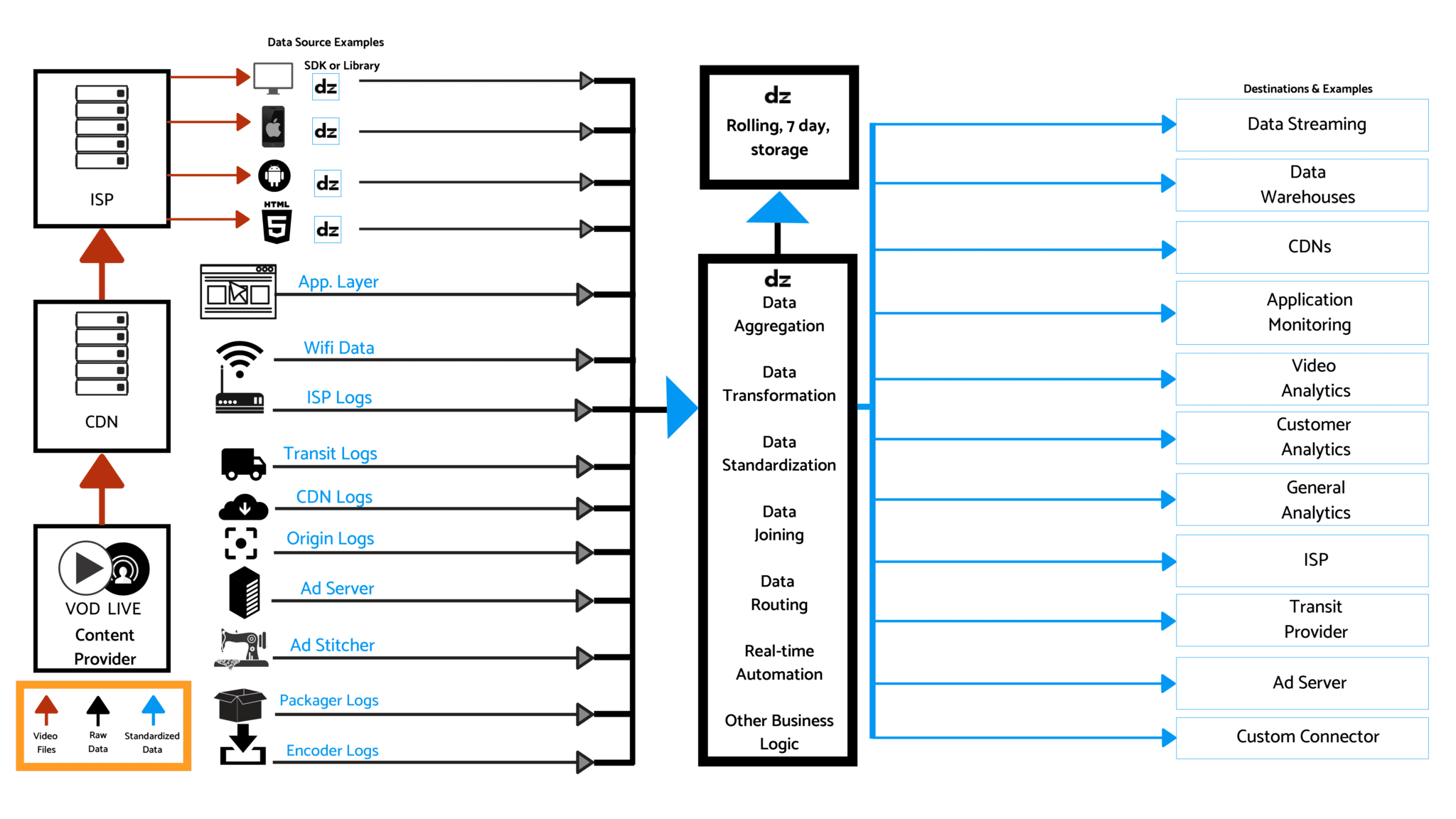Cleaning up the Mess
If you are a streaming video engineer focused on the user experience (such as player development) or in operations gathering data to resolve performance issues, you are familiar with the mess of dealing with streaming video measurement data. Not only are there countless sources of non-normalized data, but they are available through different tools, at different intervals, and often times only through a specialized SDK that must be installed within the player or server end-point. That creates serious problems when video streaming services are being held to broadcast-like quality standards. Being able to collect, collate, and send that data to wherever it needs to go (such as a visualization tool like New Relic Insights or Datadog) is critical to enable quality engineers to connect the dots between different aspects of the delivery and playback experience. What’s more, that data sometimes needs to get to those visualization tools in real-time. Unfortunately, most data collectors such as player analytics, aren’t setup to dump data in sub-second intervals anywhere. And so quality engineers and operations folks are left waiting for the data to arrive into proprietary visualization tools, sometimes woefully late, to solve critical customer issues.
What is Datazoom?
Datazoom is a real-time Video Data Infrastructure Platform that enables streaming media content providers to centrally capture, standardize, and manage the playback data used for measuring, monitoring, and powering automation across operations and engineering teams. Datazoom aims to be the central data layer from where all data originating across the workflows of preparation, delivery, and playback can be centralized and joined. Our mission is to provide a tool which makes data more actionable and improves the business of video delivery for all stakeholders.

Understanding How Datazoom Helps Clean-up the Streaming Video Data Mess
Datazoom aspires to be the “plumbing” behind the transfer and sharing of data within the video workflow. Operations engineers at the CDN want to see the experience data captured by the player. Datazoom facilitates the transference of data collected from the player to a data lake or other data repository (in sub-second real-time) for access by those CDN operations engineers. There are four components to the datazoom Video Data Infrastructure Platform which work together to make this happen.
Datazoom Top Collectors
HLS.js
HTML5
video.js
Bitmovin
Brightcove
Roku
tvOS
Amazon FireTV
Native iOS
Android Exoplayer
First are Collectors. Collectors capture data pertaining to video experiences from delivery chain technologies. At present, the bulk of our Collectors are video players (see the list of popular collectors to the right), but CDNs, Transit Providers, Encoders, Packagers, ad serving technologies, and other integral ecosystem components are on the roadmap. When data is ingested by Datazoom, patent-pending technology normalizes common data points into a single naming standard and structure documented using our Data Dictionary, which is the second component.
Our Data Dictionary maps incoming data points to a standardized analog. So if the player sends something called “screen size and pixel density,” we use our Data Dictionary to normalize that name to “screen resolution.” Because each video player or other streaming workflow technology may expose different data points, in different quantities, and under different names, the Data Dictionary homogenizes the information video providers rely on for feedback and insight.
The third component, Data Pipes, represent a visualization of a Collector and a Connector. Each Data Pipe is constructed by the customer through our simple web-based GUI. By dragging and dropping Collectors and Connectors onto a “canvas,” customers can specify, and therefore customize, data points they wish to capture. Currently, our list of Connectors includes video, customer, and general analytics systems, APM tools, and data warehouses. However, our vision is much grander!
The fourth component, Connectors, are destinations for data. As referenced above, our current Connector catalog consists of analytics systems and data warehouses. However, our ambition is to allow connectors to send data back to key ecosystem components, like CDNs, to provide real-time feedback on the status of their service to dynamically improve performance.
In short, Datazoom’s four components, as part of its larger infrastructure platform, unites the video ecosystem through real-time, standardized, raw data.
How Does Datazoom’s Technology Benefit the Streaming Video Industry?
The video industry has both benefited and suffered from its rapid expansion and well-earned successes. At a high level, Datazoom was created to serve as a foundation, a data layer, which assembles, standardizes, and synchronizes, video experience data to improve all the various processes and components integral to video streaming. Because, as you probably already know, the streaming video industry suffers from poor data.
And that malady impedes the quality of insights and limits a video distributor’s ability to make grand, data-driven, changes. For example, operational breakages are hard to pinpoint, and engineering time is wasted with one-off integrations and trials, which can increase costs. Furthermore, duplicative solutions which collect and store video experience data (the same data point may be collected several times by different SDKs), create challenges with regard to data management and organization. What’s more, since data is often collected slowly, streaming media providers miss out on critical opportunities to use data in real-time and in ways that automate change strategies aimed at improving resiliency and ultimately building relevant data feedback loops.
Datazoom’s technological approach to video experience data capture and normalization offers a holistic, centralized approach to collection, storage, and integration. The end result is improved analysis. But there are additional benefits to the industry as well. As video distributors adopt new technologies like Machine Learning and AI which require a rich, real-time data source to be effective, Datazoom will become critically important as the data capture and delivery infrastructure. Our platform, along with the Data Dictionary, will power new video experience features and services like personalization that need to react in real-time.
But there are some other tangible benefits to Datazoom’s approach as well. Rather than installing dozens of individual SDKs in a player, for example, Datazoom users can employ just one to capture a single set of experience data which can be delivered to dozens of different tools (if needed). This significantly reduces code bloat (and thereby quickens the responsiveness and load time of the player), fewer data pipes (which decreases payload and increases bandwidth for content transfers), and a reduction of data silos (which reduce insights). As well as those benefits, Datazoom provides cost control and data regulation advantages too. With GDPR and other privacy initiatives in effect, centrally managing data collection, and controlling which data goes where, is particularly helpful.
Looking to the future, we see our technology enabling streaming media providers to join and correlate other datasets . This could create a situation where a video distributor might be able to tether an individual playback session with its corresponding CDN logs. Our team is researching approaches for offering the same correlation capabilities across other traditionally client-side integrated solutions as well. These include advertising, content recommendation, and authentication technologies.
Our objective is to help the business of streaming video by making data more accessible, ubiquitous, understandable, and actionable.
Datazoom is Making an Impact in the Industry…and the Streaming Video Alliance
The Streaming Video Alliance has been the perfect environment for gathering expert opinions and advice from the technical leaders who are shaping the future of the streaming video industry. The Alliance is a forum for collaboration, diagnosing real problems, and offering potential solutions to address the unique needs our industry faces. This has enabled us to introduce our technology and approach into different working groups for consideration in solving critical technical challenges such as data collection, delivery, and normalization.
Many of the Alliance working groups are producing best practices or specifications that will serve as a foundation for ensuring a scalable, resilient approach to delivery, such as QoE, Advertising, and Open Caching. Equally advantageous, Streaming Video Alliance working groups are an effective venue for standing-up real-world POCs to test different technological approaches. Also, accessing development work with key industry stakeholders, groups that might not otherwise commit to working out individualized solutions with single organizations, has been an amazing opportunity.
We’re proud to be Grant Recipients of the Alliance. It is a privilege to be a part of an organization that shares our objectives and is similarly dedicated to adding value for businesses and expanding the ecosystem of streaming video.
About This Post
Each year, the Streaming Video Alliance opens its doors to innovative startups and small companies as part of its Membership Grant Program. For 2019, the Alliance welcomed a number of very interesting companies exploring and productizing technologies for the streaming video space. Datazoom is one of those. This blog is part of a series showcasing each of our Grant Program recipients, the technical problems they hope to solve, and the value they bring to the streaming video ecosystem.

Diane is an entrepreneur, and the CEO and Founder of Datazoom - the Video Data Platform.
-
Jason Thibeault
-
Jason Thibeault
-
Jason Thibeault



